Scottish Survey of Literacy and Numeracy 2011
The results of the 2011 Scottish Survey of Literacy and Numeracy (SSLN) which focused on numeracy.
Chapter 4: Teacher questionnaire
The teacher questionnaire was distributed to all P4 class teachers in half of primary schools, and all P7 teachers in the other half of primary schools. In secondary schools questionnaires were given to two S2 maths teachers and two S2 teachers in each of four other broad curriculum groupings ("science & technology", "social studies, religious and moral education (RME) & health & wellbeing", "expressive arts & languages" and "additional support needs (ASN)"). There were three versions of the questionnaire (primary, secondary maths, secondary non-maths) though many of the questions were consistent across the three versions.
It should be noted that introduction of the Curriculum for Excellence in secondary schools started with S1 in 2010/11 and this will continue upwards as that cohort progresses through the stages. The secondary school teachers answering the 2011 questionnaires were therefore yet not following the Curriculum for Excellence with their S2 classes. However the survey still acts as a benchmark of their views and experiences.
As with all sample surveys, there are margins of error around the results. The size of these vary but, as a rule of thumb, for primary and secondary non-maths teachers they are generally about ± one to two percentage points. For secondary maths teachers and three of the four secondary non-maths teacher groups, they are about ± two to four percentages points, with about five percentage points for additional support teachers. Standard error data for these calculations are provided in the data tables. The data were weighted to account for school size and non-response.
4.1 Teaching numeracy across the Curriculum
In terms of the different topics within numeracy, primary school and secondary maths teachers reported very high levels of confidence in delivering the numeracy curriculum. Levels were lower among secondary non-maths teachers, though amongst these the results varied between teachers of "science and technology" and "expressive arts and languages".
Chart 4.1: Percentage of teachers reporting they were "very confident" or fairly confident" in delivering the numeracy experiences and outcomes, by topic, sorted by non-maths.
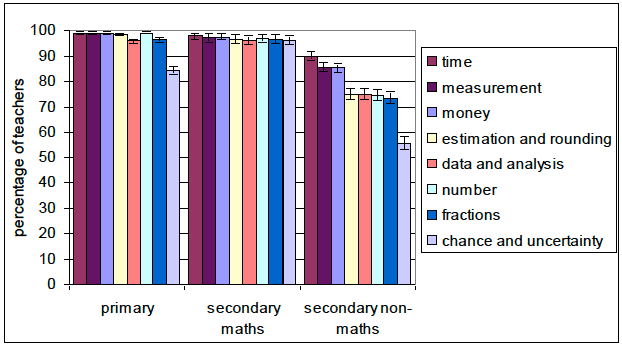
Amongst non-maths teachers, ideas of chance & uncertainty, and to a lesser extent fractions, number processes, data & analysis, and estimation & rounding were the areas about which they felt least confident, with ideas of chance & uncertainty also scoring lower amongst primary school teachers.
Primary and secondary non-maths teachers were asked how well they could integrate the numeracy experiences and outcomes into different areas of the curriculum. The following graphics summarise the responses. Amongst both groups of teachers, sciences and technologies were the areas where teachers saw most scope for inclusion of numeracy teaching, with expressive arts, languages and religious and moral education the most difficult.
Chart 4.2: How well can the following skills be integrated into teaching the various curriculum areas? Primary teachers, average response.
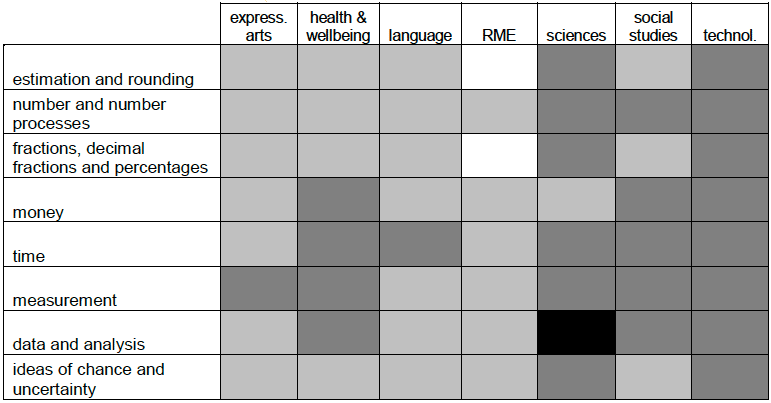
Chart 4.3: How well can the following skills be integrated into your curriculum area? Secondary non-maths teachers, average response.
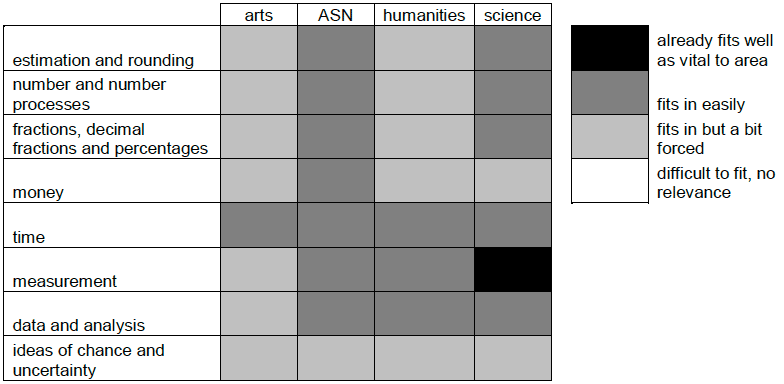
Secondary non-maths teachers were also asked how often they found opportunities to reinforce pupils' numeracy skills. Their responses reflected the above graphics, with 84 per cent of additional support teachers and 82 per cent of science and technology teachers reporting they could do so at least most weeks, compared with 35 per cent of expressive arts and language teachers.
4.2 Aspects of Curriculum for Excellence
Teachers were asked about their levels of confidence with understanding various aspects of Curriculum for Excellence. The highest rates were in primary schools. Between 85 and 95 per cent of teachers were confident they understood the experiences and outcomes for their area, but about 20 per cent of secondary school teachers said they were not confident they understood the concepts of breadth, depth and challenge. Primary school teachers were more confident about literacy, numeracy and health & wellbeing across learning, with maths teachers reporting lower levels of confidence about literacy and health & wellbeing across learning.
Chart 4.4: Proportion of teachers reporting they were "very confident" or "fairly confident" that they understood aspects of Curriculum for Excellence.
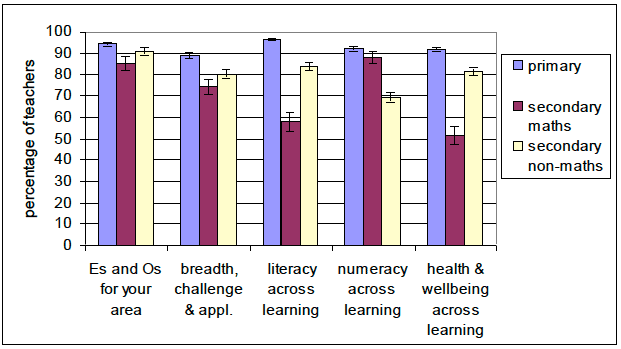
Teachers were also asked how confident they were that they could improve learning using each of these aspects. The results showed similar patterns to the above, with about 94 per cent of primary teachers and about 81 per cent of secondary teachers reporting they were "very confident" or "fairly confident" that they can improve learning using the CfE experiences and outcomes for their area. About 60 per cent of secondary non-maths teachers were confident that they could improve learning using the experiences and outcomes for numeracy across learning.
4.3 Classroom activities and resources
Teachers were asked how often pupils in their classes spend time doing a range of activities. Full results are available in the data tables but the activities which the highest percentages of teachers reported pupils undertook on "most days" were "being taught with the whole class together", "working quietly on their own" and "talking about what they are learning in pairs or in groups". Over a half of primary teachers also reported "discussing everyday uses of what they are learning" with pupils most days, with 85 per cent "finding out by exploring or investigating" and 36 per cent "working outside the classroom" at least most weeks.
Primary and secondary maths teachers were asked about the numeracy resources which they make use of. The most commonly used resources were commercially produced materials (e.g. textbooks/software packages), Curriculum for Excellence experiences and outcomes, and interactive whiteboards.
4.4 Professional Development
Teachers were asked how often they had taken part in various forms of continuing professional development (CPD) in the last twelve months and, if they had, how useful they had found it. The CPD related to CfE numeracy experiences and outcomes only, which explains why secondary non-maths teachers returned lower participation rates than others.
Amongst primary school teachers and secondary maths teachers the most frequently used forms of CPD were reading and discussing the numeracy experiences and outcomes with colleagues, professional enquiry through reading/personal study and reading and discussing the CfE guidance/exemplifications with colleagues. About 40 per cent had taken part in coaching/mentoring, and 28 per cent of primary and 12 per cent of secondary maths teachers had taken part in visits to other schools to observe good practice.
Chart 4.5: CPD activity in numeracy in last twelve months, with level of impact.
Primary school teachers.
(see data tables for full descriptions and for responses for secondary school teachers)
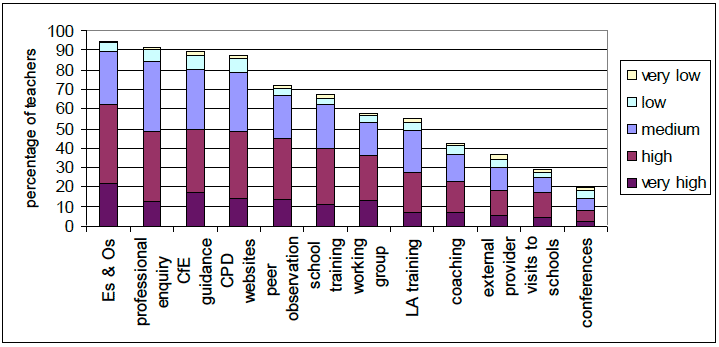
The activities with the highest rating for level of impact were reading and discussing the numeracy experiences and outcomes with colleagues, peer observations and membership of working groups, with over 60 per cent of those participating rating their impact as "high" or "very high" amongst primary school teachers and over 50 per cent among secondary maths teachers.
Contact
Email: Marion MacRury
There is a problem
Thanks for your feedback